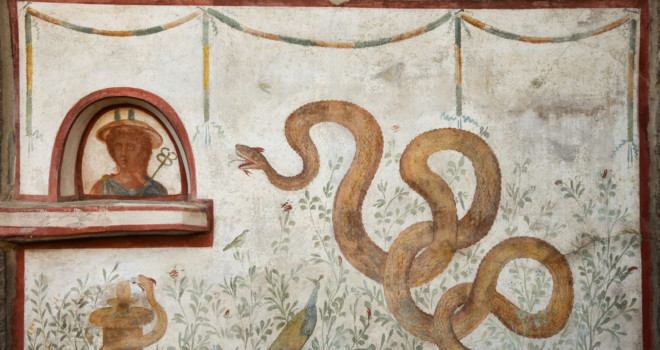Have you ever considered that the devil is active in your prayer life? In the parish church where you attend Mass? In the lives and actions of people of goodwill all around you? The saints remind us of a key aspect of living the spiritual life that we are wont to forget simply because we can’t see it and because we have been conditioned by the media and popular culture to think the devil works visibly only in “bad” people or in extraordinary ways, as in the movies. And although demons are certainly capable of extravagant or extraordinary manifestations, their ordinary work flies under our radar because it just isn’t that spectacular, though it is deadly. In fact, subtlety, illusion, and deceit are their preferred methods of attack. An invisible battle for souls is being waged in and around us without reprieve, and we remain ignorant of it to our peril.
St. Teresa of Avila, great mystic and Doctor of the Church, is best known for her writings on the way God leads souls along the path to union with Him through prayer. What many do not know about St. Teresa is that she also observed the actions of demons working with militant force to lead even good souls astray in ways that might surprise you. She shares these experiences freely in her autobiography, which she was commanded to write under obedience to her spiritual director.
In one instance, Teresa describes how she turns cold and tenses as she comes face-to-face with the eyes of two demons during Holy Mass as she knelt to receive Communion. “They are hideous with horns that seemed to encompass the throat of the poor priest,” she writes, and she averts her eyes from the demons and instead stares intently at the Eucharist:
and I beheld my Lord, in that great majesty of which I have spoken, held in the hands of that priest, in the Host he was about to give me. It was plain that those hands were those of a sinner, and I felt that the soul of that priest was in mortal sin. What must it be, O my Lord, to look upon Thy beauty amid shapes so hideous? The two devils were so frightened and cowed in Thy presence, that they seemed as if they would have willingly run away, hadst Thou but given them leave. So troubled was I by the vision, that I knew not how I could go to Communion. I was also in great fear, for I thought, if the vision was from God, that His Majesty would not have allowed me to see the evil state of that soul.
St. Teresa of Avila, The Life of St. Teresa of Jesus of the Order of Our Lady of Carmel, 5th ed., trans. David Lewis, ed. Benedict Zimmerman, O.C.D. (New York: Benziger Brothers, 1916)
She then reveals the Lord’s direction to her:
Our Lord Himself told me to pray for that priest; that He had allowed this in order that I might understand the power of the words of consecration, and how God failed not to be present, however wicked the priest might be who uttered them; and that I might see His great goodness in that He left Himself in the very hands of His enemy, for my good and for the good of all. I understood clearly how the priests are under greater obligations to be holy than other persons; and what a horrible thing it is to receive this most Holy Sacrament unworthily, and how great is the devil’s dominion over a soul in mortal sin. It did me a great service, and made me fully understand what I owe to God. May He be blessed for evermore!
St. Teresa writes of another terrifying encounter with the demonic forces of Hell and the power they hold over a soul who fails to live in a state of grace:
At another time I had a vision of a different kind, which frightened me to the core. I was in a place where a certain person died, who as I understood had led a very bad life, and that for many years. But he had been ill for two years, and in some respects seemed to have reformed. He died without confession. . . . When the body had been wrapped in the winding-sheet, I saw it laid hold of by a multitude of devils, who seemed to toss it to and fro, and also to treat it with great cruelty. I was terrified at the sight, for they dragged it about with great hooks. But when I saw it carried to the grave with all the respect and ceremoniousness common to all, I began to think of the goodness of God, who would not allow that person to be dishonored, but would have the fact of his being His enemy concealed. I was almost out of my senses at the sight. During the whole of the funeral service, I did not see one of the evil spirits. Afterwards, when the body was about to be laid in the grave, so great a multitude of them was therein waiting to receive it, that I was beside myself at the sight, and it required no slight courage on my part not to betray my distress. I thought of the treatment which that soul would receive, when the devils had such power over the wretched body. Would to God that all who live in mortal sin might see what I then saw — it was a fearful sight; it would go, I believe, a great way towards making them lead better lives.
St. Teresa’s writings are replete with references to the devil and his nefarious engagement with those who seek God and those, as revealed in the two accounts above, who don’t — or those who seek God but don’t understand or engage in spiritual warfare. Her reflections reveal the wisdom she gained through her encounters with the enemy, encounters that also occur in the experience of every soul who seeks to follow God.
Why did God reveal these things to her? The answer is not complicated. St. Paul said, “Be imitators of me as I am of Christ” (1 Cor. 11:1). The saints are given to us by God not only to show us how to become saints but to help us fight the daily battle against the father of lies and his legion of demons. St. Teresa is more commonly known as the Doctor of Prayer; however, those who know her writings well might call her the Doctor of Spiritual Warfare because this is a prominent theme woven through all of her work.
Our treatment of her wisdom in this area will focus on her greatest and most mature work, The Interior Castle. In this spiritual classic, we have two elements that provide unique insights into the mystic’s success in the realm of spiritual warfare: first, her practical wisdom and observations; and second, her understanding of the progressive nature of the life of the soul and how the enemy works to adapt his schemes and temptations depending on where the soul is on the spiritual journey. If we take Teresa as our guide, we will surely gain clarity and wisdom and be far more victorious in our encounters with the forces of darkness as we seek to know and follow Jesus.
St. Teresa deals with myriad challenges and remedies regarding the spiritual progress of souls. Our method of exploration will seek to address only those challenges that she specifically attributes to the enemy of souls and how these can be thwarted or successfully dealt with at each stage of spiritual experience. As with any journey, it is best to plan ahead and know what to expect along the way, from the beginning to the final destination; the journey through the spiritual life on the way to union with God is no different.
You might be tempted to stop reading when the experiences of the journey St. Teresa describes seem so far from your own. This inclination to pause or stop is ill advised and likely from the evil one himself. Why? Because the ultimate tactic of the enemy is to prevent a soul’s progress toward God, whenever and however he can. And he is tireless in his efforts. St. Teresa gives a map to the treasure in the heart of the castle, and along the way, she points out clearly where the devil is lying in wait and how he is most likely to reveal himself. The devil’s sole aim is to prevent each soul from reaching the goal, and he disguises himself in the process. He will make every effort to waylay you: to get you to pause, to walk another (easier) path, to give up, or to believe that what is good is actually bad, or vice versa. Not only is the enemy seeking to keep you from union with God, but he is also trying to get you off the path and to deceive you and lure you, inch by inch, toward Hell.
You are therefore strongly encouraged to commit to a thorough and reflective reading of this text to become familiar with the wiles of the enemy as he seeks to stifle the growth of every soul. In addition, as you understand, diagnose, experience, and successfully battle against these tactics, you will be able to assist others in growing through the same circumstances and truly live out the spirit of St. Teresa: to support and strengthen your brothers and sisters in Christ in the battle against the devil in the castle.
Finally, a word about our method of reflection on Teresa’s wisdom. Because of her wandering writing style, and because the focus of this book is a reflection on her writings, I will quote from her work only when it is directly helpful. Otherwise, in each section, you will be referred to the general location of Teresa’s thoughts in The Interior Castle itself as an encouragement to undertake a simultaneous and prayerful reading of that extraordinary work, which cannot fail to be of great benefit to you.
✠
Editor’s note: This article is adapted from a chapter in Dan Burke’s latest book, The Devil in the Castle: St. Teresa of Avila, Spiritual Warfare, and the Progress of the Soul. It is available from your local Catholic bookstore or online through Sophia Institute Press.














